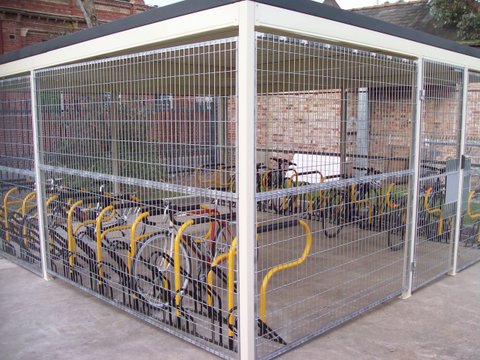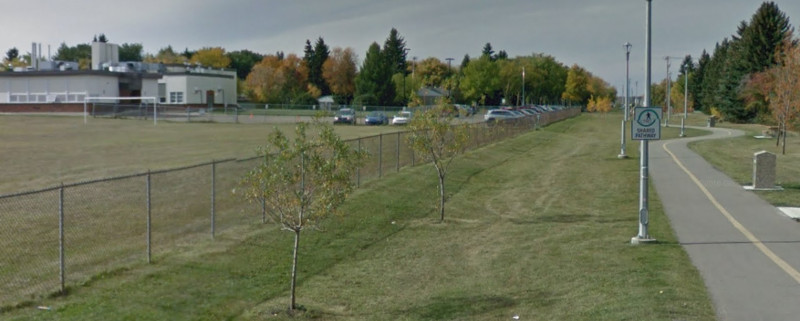On Wednesday evening Michael Janz organized a community discussion focusing on eliminating the barriers to active transportation to and from schools. I was happy when I was invited to attend - this is something I've thought a lot about, not just from a school context, but as a holistic approach to revitalizing neighbourhoods. Nothing reinvigorates communities quite like getting people out and interacting with each other, and nothing builds habits quite like learning them in your youth.

All told, over 20 participants from diverse backgrounds participated and shaped the discussion
The primary objective of the meeting was to walk away with three letters, one to the Government of Alberta, one to City Council and one (in a self-addressed envelope) to the Public School Board detailing exactly what we came up with, and suggestions for how the situation can be improved, and the discussion continued.
As the exercise continued, however, it became quite readily apparent that no single entity was entirely responsible for any of the changes we'd like to see. For example, a common theme was the desire for high-quality, secure bike lockups at schools.

Bike cages are the gold standard of what schools might have for bicycle lockup
But who is responsible for such infrastructure? Is it a funding problem from the provincial government? Is EPSB simply not planning and allocating design space for secure bike lockups? Should the City be part and parcel to these discussions and integrating school designs with the active transportation network?
The answer, probably, is yes.
So, in the interest of actually talking about solutions, I'll spend less time breaking the responsibilities down by order of government, and instead focus on the priorities that need to be set to enable kids to use alternative modes of transport to schools. However, it's important to recognize that every order of government plays a big role here, and needs to have a seat at the table.
Active collaboration and regular sharing of initiatives and priorities between the Provincial and Municipal governments as well as the with the school board will be absolutely necessary to properly ensure every school empowers its students to use active transportation wherever possible.
Bike Lanes / Pedestrian Infrastructure
It's simple and obvious, sure, but that doesn't make it unimportant. The debate on bike lanes takes one form when we're talking about commuter networks for bicycles, but there's a different context in terms of getting kids to school. Consider, when a kid turns seven or eight, they'll graduate up a size of bicycle to above 50cm wheel diameter - the magic threshold that makes cycling on the sidewalk illegal.
There are good reasons for this and bad reasons for this, but the idea behind it is solid: at intersections, it's expected the sidewalk will have people walking, not cruising along on bicycles. There are significant safety concerns with having larger bikes move quickly along sidewalks, both for the cyclist as well as pedestrians that are trying to use that sidewalk.
Do we really want an eight-year-old kid riding in heavy traffic (due to high numbers of parents dropping kids off) on his bicycle, or would we rather have him in his own, separated, dedicated space?
Kids need ways to get to school separate from cars. This is not to prescribe only bike lanes, the solution needs to be designed at a neighbourhood-level (which is where the collaboration, especially with City Council comes in). Kids should have options for getting into their schools without having to cross in front of many idling/pulling-in/pulling-out cars as parents are dropping off children.
In Hazeldean, we have a greenway running through the centre of our community with a multi-use trail, and it has direct sidewalk and soccer-field access to the school. The crossing is a full-priority traffic light, that goes red when a pedestrian pushes the button (without a minutes-long wait).

The greenway is also lit - very helpful in winter mornings and evenings
School Drop Off Zones
Continuing on with a similar thread, school drop-off zones came up as a huge issue for parents in the room. Drop-off zones have a tendency to be directly in front of schools where, by necessity of going there kids who are walking must cross in front of parents pulling in and out, as well as heavy traffic volumes.
Designing schools and drop-off zones such that drop off areas are away from the doors is an excellent start. Even better, we discussed the possibility of moving drop-off zones a couple of blocks away from the schools. This would actually be a trivially simple solution that solves many problems:
- Kids who live out of the neighbourhood still get some active transportation
- Kids who live in the neighbourhood, within a few blocks (but inexplicably drive, which I'm assured is something that happens) would now have no real incentive to drive.
- Schools become a much less chaotic area
Naturally, some considerations would need to be made for children with disabilities. But we already make similar considerations everywhere else, that doesn't really strike me as an issue.
Lower neighbourhood speed limits
This would be something cities might be enabled to do under the new city charters, and lowering the neighbourhood speed limits was reintroduced for debate by Councillor Knack last week.
It's something I've spoken on before, but consider what message a school zone sends. School Zones, in some cases, do not even extend around every side of a school, but are simply applied to roadways directly in front of schools. These roadways often correlate with drop-off zones. We know that the 30km/h speed limit around schools has led to a significant increase in safety. But consider that the school zone is telling our neighbourhood kids they're only safe directly in front of the school. Just far enough to get into a car, where they can be safe for the rest of the trip home.
It creates school zones as a "special" area where safety is important - but the rest of the neighbourhood where the kids inevitably have to walk to get home has no such special safe status.
I recognise that 30km/h might be too much of a change for many Edmontonians. There are certainly advantages, but I'm a strong advocate of not letting perfect be the enemy of good. In Hazeldean, I have actively been pursing a compromise of 40km/h as the neighbourhood speed limit and have seen strong support from my neighbours. If we want neighbourhoods to be places where we can walk - where our kids can walk - certainly the discussion of reducing speed limits in neighbourhoods needs to be on the table. It needs to have been on the table years ago.
Potpourri (other things that came up)
There were many other pieces of feedback: from the fairly self-explanatory $$$, to recommendations on snow-clearing, debris, and windrow removal. Affordable transit came up as an important piece to augment active transportation, especially in the colder months. Often, it's simply cheaper to drive. Curriculum changes to ensure that every student was getting a base, and consistent from school to school, understanding of cycling safety and how bicycles can safely interact with other modes struck a chord with the group as something to be pursued.
Most interesting to me, however, was hearing from the affected parties. Present at the meeting were two young elementary students. When they were asked for feedback, little thought was required. To them, the answer was obvious:
No more indoor recess!
They didn't care if it was raining. They didn't care if the "windchill" was -25. They wanted to get outside and play and be active. That was indicative for me - these girls very much wanted to be outside, but in this case the school system was holding them inside. I see a similar situation with our infrastructure: perhaps if we better enabled and encourage active transportation to school, we'd see excitement from a healthy population ready to do it.
Even just a 1% increase in kids walking to school could mean over a thousand kids out and walking twice a day, every school day.
Closing
While we certainly have a long way to go on many of these initiatives, I believe it's important to take stock of where we are and the improvements we've already made. David Shepherd has submitted a private members bill to create the "Active School Week Act" to encourage walking and biking to school. Communities like Belgravia have created walking school buses to get kids out and walking to school together. We'll have a minimum bike grid downtown, as well as along 83rd avenue. And the city no longer seems to believe that pedestrians need to look like their clothes are sewn with radioactive thread.
But, as the city pursues Vision Zero which I strongly believe in, I think we'll have the tools to really make positive changes happen for the people, and schools, in our communities.